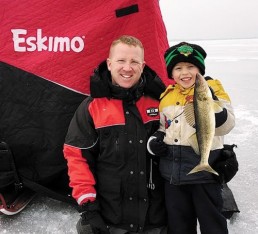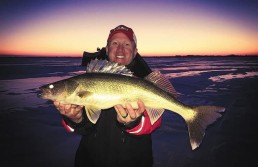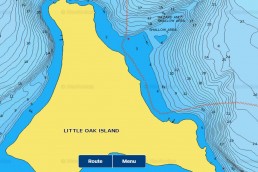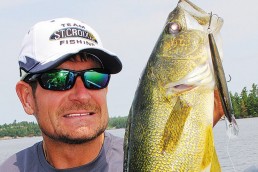Chasing Early-season Winnebago Walleyes
The Lake Winnebago system, also known as the Winnebago Pool in northeast Wisconsin, is no secret when it comes to walleye fishing. Known as one of the top walleye factories in the Midwest, the Winnebago pool of interconnected lakes (Lakes Poygan, Winneconne, Butte des Morts and Winnebago) combine to encompass more than 166,000 acres and account for nearly 17 percent of the total surface water area in Wisconsin (not counting the Great Lakes).
The system is unique in so many ways, that finding walleyes during the hardwater season is anything but easy. I frequently tell my clients that the walleyes in this system have yet to read any books or watch any videos on the patterns and methods of a typical walleye.
When looking for walleyes on the Winnebago system under the ice, you won’t find them along the edges of reefs or along weed lines like you would in a northern Minnesota or northern Wisconsin lake. The walleyes, along with crappies, perch, white bass and sheepshead, will school together and chase bait over the flats on all the lakes.
It starts in late fall when a migration of walleyes and white bass will make their way from Lake Winnebago up the Fox and Wolf Rivers chasing the shiners and shad that are dumping into the system from all the small tributary creeks and streams. As fall progresses into winter and the lakes begin to freeze, the current from the rivers subside, the baitfish will scatter throughout the system, and fish will begin to school in small groups, chasing the baitfish throughout the upper lakes and Lake Winnebago.
The search for fish begins.
At just over 14,000 acres, Lake Poygan averages a depth of 6 to 7 feet and is usually the first lake in the system to ice over. Generally by the first to second week in December, anglers are starting to venture onto the south and west ends of the lake by foot. Because there is no structure that the fish relate to, it becomes an intense workout using the auger and depthfinder to locate schools of fish. Even though the fish have no structure to relate to, they will follow contour breaks. Using the GPS that is part of my Humminbird Helix 5, with a LakeMaster chip in it, lets me follow contour breaks, where the fish will tend to be at first ice. Don’t be discouraged if you only find breaks of half a foot or less. The subtle changes in contour are all the lake has to offer. First-ice on Lake Poygan can be like fishing in a barrel once you locate the schools and will continue to be excellent fishing until fishing pressure increases as ATV and vehicle traffic progress.
Catching fish from the shallow waters of Lake Poygan can be fairly easy when you have the right gear. A lot of the fish caught throughout the year are caught just below the ice in 4 feet of water or less. For the rod and line, I like the 13 Fishing 27 1/2-inch ML White Out rod, spooled with 6-pound-test Berkley fluorocarbon line. This setup gives plenty of hook-setting power but has a tip that’s responsive for fighting the big girls that decide to run.
Attached to the line will be one of three different styles of baits. The 1/8-ounce Custom Jigs & Spins Slender Spoon, in hammered gold or hammered nickel, is one of my top-producing baits. Other good choices are Swedish Pimples in the #2 or #3 sizes in the same hammered gold or hammered nickel, and #2 or #3 Rapala Jigging Raps in any of the UV colors, Parrot or the black-and-gold. With all the lures, no live bait is added and a steady snap and free fall motion is the technique used to call the fish in. Once a fish has zeroed in on the lure, a small twitch while slowly bringing the lure up at the same time will usually trigger the strike.
Another extremely effective method the past couple of years has been the use of box tip-ups. The Bite-Me Box Tip-Ups are a heated box with a reel inside that has almost no resistance, allowing the fish to take the bait without feeling a thing. The key to success with the tip-ups is the use of #20 treble hooks attached to 4- or 6-pound fluorocarbon leaders. This method defies the unwritten rule that big fish require big hooks. This past season, numerous walleyes up to 30 inches were caught using 4-pound test leaders with #20 trebles and medium fatheads with the tails clipped. Along with the walleyes, we caught perch, white bass, crappies even a bluegill.
When setting up the tip-ups, find a contour line and set a few up along the line away from the area you will be jigging. Keeping the noise around the tip-ups to a minimum will increase your odds, especially when there is little to no snow on the ice.
As pressure increases from other anglers, tight groups of up to a few hundred people will form and play leapfrog throughout the day, as the school of fish gets chased around the lake. If this type of craziness doesn’t bother you, feel free to jump in the group and observe the anglers next to you. You should get some action for short periods of time. However, if you prefer unpressured fish that tend to stay in an area for the majority of the day, get away from the crowds and find your own school of fish. Just make sure not to promote the area, as any more than a few guys on a spot will draw the crowds to you.
Moving into late December, the ice on Lake Winnebago should firm up, allowing anglers to start the search on the “Big Pond.” Due to its size, finding fish out there can be a lot more challenging. First areas to start include spots out from the mouth of the Fox River in Oshkosh and the mudflats, which start about 1 mile offshore. Having a group of friends to network with is an effective way to eliminate water while searching for the schools. Unlike the upper lakes, walking isn’t really an option, so most fishermen won’t start venturing out until there is enough ice for ATVs or snowmobiles. This instantly creates pressure but does not seem to bother the fish so much, because of the deeper water. Lake Winnebago averages a depth of about 15 feet, and most areas in the mudflats are about 18 feet. The same baits and jigging techniques used on Lake Poygan are used on Lake Winnebago, however the sizes of the baits are increased slightly. Tip-ups are also effective but can be a hassle due to the amount of moving required to locate the schools of fish.
The Lake Winnebago Pool of lakes can offer some of the best walleye fishing in the Midwest throughout the ice season. If you are unfamiliar with the system, remember it is a river system, and current flows through the lakes all winter. Always check with the local fishing clubs, bait shops or guides before heading out to make sure ice conditions are safe. Stay clear of the river channels and be prepared for any unforeseen issues that may arise with unsafe ice. A flotation suit like the Striker Ice Climate will keep you afloat should you fall through, and always make sure someone knows where you are going.
Troy Peterson, “Mr. Bluegill,” owns and runs Mr. Bluegill Guide Service out of Oshkosh, Wis, and grew up on Lake Winnebago and has been fishing the system his entire life. You can view his weekly reports with instructional videos on his website, mrbluegill.com, as well as a weekly column. Peterson is also a member of the Association of Great Lakes Outdoor Writers and delivers seminars across the Midwest. To see videos on how to jig for walleyes including different baits and rod setups, visit Troy Peterson’s YouTube Channel: youtube.com/mrbluegill.
MWO
SHARE THIS POST
Did you enjoy this post?
You can be among the first to get the latest info on where to go, what to use and how to use it!
Troy Peterson
Troy Peterson, “Mr. Bluegill,” owns and runs Mr. Bluegill Guide Service out of Oshkosh, Wis., and grew up on Lake Winnebago and has been fishing the system his entire life. You may view his weekly reports with instructional videos on his website, mrbluegill.com, as well as a weekly column on the Gannett newspaper website, wisconsinoutdoorfun.com. Peterson is also a member of the Association of Great Lakes Outdoor Writers and delivers seminars across the Midwest. To see videos on how to jig for walleyes including different baits and rod setups, visit Troy Peterson’s YouTube Channel: youtube.com/mrbluegill.




